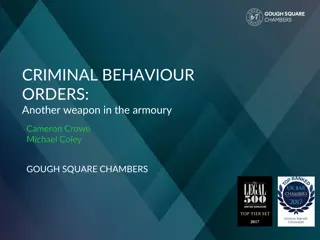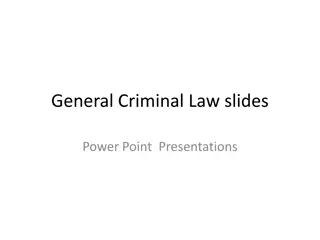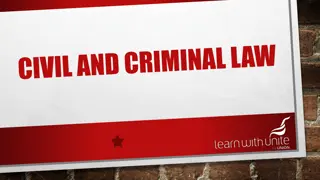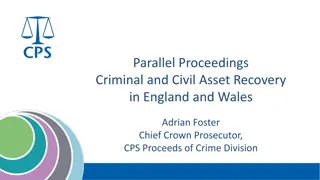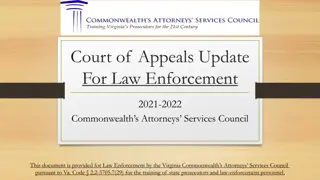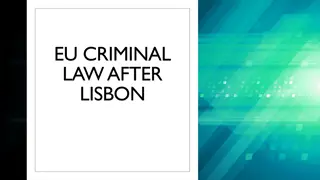Criminal Law and Procedure in England: An Overview
S.F.C. Milsom provides insight into the historical development of criminal law and procedure in England, highlighting the challenges and evolution of the legal system. The lecture delves into the ancient patterns of lawsuits, the role of inscrutable decision-makers, and the emergence of an organized prosecution. It also discusses the significance of the criminal trial jury and the complexities faced in societal concepts of homicide.
Download Presentation

Please find below an Image/Link to download the presentation.
The content on the website is provided AS IS for your information and personal use only. It may not be sold, licensed, or shared on other websites without obtaining consent from the author.If you encounter any issues during the download, it is possible that the publisher has removed the file from their server.
You are allowed to download the files provided on this website for personal or commercial use, subject to the condition that they are used lawfully. All files are the property of their respective owners.
The content on the website is provided AS IS for your information and personal use only. It may not be sold, licensed, or shared on other websites without obtaining consent from the author.
E N D
Presentation Transcript
English Constitutional and Legal History: Criminal Law and Procedure Lecture 11 Click here for a printed outline.
The position of this lecture in the course This lecture was originally designed as a lecture principally for law students. FAS students should feel free indeed are encouraged to ask questions about it in class. The FAS students should also know that only they are responsible only for the medieval part of the lecture. The Hay-Langbein debate, with which we will deal at the end of the lecture is important, but not for the details about the 18th century criminal process, but, rather, for what it offers as a method for dealing with debates among historians about any period..
Criminal law and procedure in England an overview S.F.C. Milsom: The miserable history of crime in England can be shortly told. Nothing worth-while was created. The common law of substantive crimes was a mess; the procedure only slightly less so. That they managed at all is a tribute to a practical people with some sense of decency, but the unsatisfactory state of our modern criminal law and procedure owes much to it. We have after all a criminal procedure that we can afford only for a tiny fraction of the criminal defendants, O.J. Simpson and Whitey Bulger. The rest cop a plea. In the meantime the victims of crime end up feeling like the criminals. Something seems seriously wrong with the system today, and unfortunately I have to report that a great deal (though not all of it) is attributable to the history that we are going to cover today. There is also, in many people s view, structural racism built into the modern American criminal process. That s a product of American history, not the history we will tell today.
Criminal law and procedure in England overview (contd) The ancient pattern of lawsuit : a formal charge or complaint, a blanket denial, which is then submitted to an inscrutable decision- maker. The ancient pattern of lawsuit may go back to Anglo- Saxons. Certainly some use of inscrutable decision-makers does. At various points in the MA it may be possible to penetrate what lies behind the ancient pattern of the lawsuit, which, by and large, is what is found in the records, which begin to be abundant in the 13th century. The inscrutable decision-making of the ordeal was quite quickly replaced by a decision-maker that is, for the most part, equally inscrutable on these records, the criminal trial jury. Thomas Green and Liz Kamali have been able to penetrate into societal concepts of homicide by methods that we ll come to in a minute, but the work has to be done carefully, and in my view much of the recent work has not been.
Lawyers (as opposed to judges) come into this process very late. The rise of an organized prosecution was very slow in coming. We see hints of it in the activity of the justices of the peace in the later MA, and the mid 16th century sees an important statute which to a certain extent codified their activity. The notion that the prisoner must defend himself died hard, and in a world where the jury was self-informing, it may not have made much difference. When the jury ceased to be self-informing as a practical matter we don t know. It was still thought of as being self- informing well into the early modern period. The political trials of the 17th c. did much to create a catalogue of things which the criminal defendant should be able to claim as of right, and our constitutional protections for criminal defendants have their ancestry in this period. But even in the 18th century the majority of criminal trials seem to have been conducted without counsel on either side. This had obvious effects on the law, and Milsom sees them as mostly bad.
Transition The subject is worth more than an hour, but we only have an hour for the lecture. It will be devoted largely to making some points about jurisdiction and procedure and the relation of the two to substantive law. The points about jurisdiction and procedure and their relationship to substantive law will be reinforced quite dramatically when we come to the personal civil actions, contract and tort.
Criminal vs. civil The fundamental distinction between the two in Roman law, and probably in our own, seems to be that in the criminal case what is being sought is the punishment of the defendant, whereas in civil cases what is being sought is the recompense of the plaintiff. In the United States, by and large, only a public officer can bring a criminal case. That, however, was not the case historically nor is it the case today in England and in a few of our states. Felony vs. trespass is a dichotomy that Glanvill would have understood. Glanvill also gives us a classification of civil and criminal. It comes from Roman law, but he does not apply it in the way that the Romans did. As Glanvill applies the distinction, it divides the land law and debt/detinue and covenant, on the one hand, from the law of wrongs on the other. Civil actions for Glanvill focus on the plaintiff s right, whereas criminal actions focus on the defendant s wrong. So far as the law of wrongs is concerned who pursues the action is irrelevant to Glanvill. On the side of the law of wrongs we can make some distinctions that will help to explain Glanvill s and later usage of the terms
Criminal vs. civil (contd) Who pursues? Will it be private pursuit, in which case it will be by way of what is known as an appeal or will it be the community that pursues the action, in which case it will be by way of indictment. Is it a felony or a trespass? Is the offense a plea of the crown or is it not? If it is a plea of the crown, is it a plea of the crown because the act was done with force against the peace of the king (contra pacem domini regis) or not?
Criminal vs. civil (contd) The private pursuit of a plea of the crown that is trespass not felony will become by the mid-thirteenth century a civil action of trespass in the central royal courts. It will have a glorious future that is the subject of the next main section of the course. If it is the communal pursuit of a trespass, it will be a misdemeanor. If it is a felony, it will be a felony. In both felonies and misdemeanors, the law will remain fixed, at least in the central royal courts, probably in all the king s courts. Force and arms must always be there and hence the curious definition of common-law larceny. There must be a taking from the possession of the victim. Embezzlement may have been actionable in the local courts, but the criminal jurisdiction of the local courts went down the tubes sometime in the fourteenth century.
Indictment and trial Coroners as early as he reign of Henry I. The assize of Clarendon (1166) and the assize of Northampton (1176) give us a substantial glimpse into a procedure before the justices. The rise of grand jury procedure. Clarendon seems to have changed the method of proof. In all cases of suspicion we will have an ordeal. Previously, it seems to have been that defendant could get off by compurgation, oath-helping, if there were no corpus delicti, physical evidence of the crime, such as the body of a victim of homicide. The grand jury is going to have a glorious future. Verdicts of true bill or ignoramus (12 out of 23 grand jurors). Perhaps as early as the sixteenth century it is going to combine with the justices of the peace (JP s) to perform an investigative function. Police, as we understand them, do not come until early in the 19th century, though there are some 18th-century foreshadowings in the JP s that sat in London. Ordeal replaced by petty jury after 1215. The Fourth Lateran Council of that year may not be as important as Baker makes it out to be.
Indictment and trial (contd) If the defendant refuses to put himself on the jury, the Statute of Westminster I (1275) says that he should be put in a prison forte et dure. This becomes the grisly peine forte et dure. Because the defendant has chosen the jury, the criminal trial jury cannot be attainted. A 1352 statute allowed challenges to indictors who were also on trial jury. The statute may have put an end to the practice of using a piece of the grand jury as petty jurors. Bushel s Case (1670) holds that criminal trial jurors cannot be punished for rendering a false verdict. A consequence of Bushell s Case is that the development of substantive law is thwarted. If you can t inquire into whether the jury got it wrong, there is no need to inquire what wrong might be in this context.
Indictment and trial (contd) We have a pretty good idea of how trial procedure worked in the 18th century. Chapbooks, judges notebooks, Dudley Ryder s (CJKB, 1754 56) notebooks, show us a procedure without lawyers. The JP conducted a preliminary investigation, perhaps presenting the case to a grand jury. He also bound over the victim to prosecute and the witnesses to appear. Hence, a group of non-professionals will appear in court and tell their story. The judge asks questions. Speedy trial is decidedly the rule. The jury may hear several cases before retiring to consider their verdicts, and since they were not entitled to have anything to eart until they rendered a unanimous verdict, they tended to come up with a verdict pretty quickly. The judge can, and does, comment on the evidence, and the jury usually follows his advice, but not always. Conviction rates are not nearly so high as they are today. In 1836 a statute put an end to uncounseled prisoners; defense counsel was allowed to appear at trial. Counsel had, in fact, begun to appear on a fairly regular basis in ordinary criminal cases in the late 18th century. The Treason Statute of 1695 had given those accused of treason a right to counsel, but it took about 75 years for this to penetrate into ordinary criminal case.
Indictment and trial (contd) Criminal courts: In the thirteenth century the eyre was a, if not the, principal court that heard serious criminal cases. Magna Carta c.17 (which requires that common pleas be held in some fixed place) gradually led to the exclusion of criminal cases from the Common Bench. We are poorly informed about when this became a rule. King s Bench always had criminal jurisdiction, but it tended to hear only the more important or more political cases. With the decline of the eyre criminal cases were heard in the country by commissioners. Commissions of oyer and terminer, gaol delivery, trailbaston were eventually consolidated into one commission along with assize commissions and commissions of nisi prius. In the 14th century, keepers of the peace become JP s and held quarter sessions.
A criminal verdict cannot be appealed. Hence, avoidance of punishment became a device for review. Pardons were by far the most important of these devices. The rise of conditional pardoning in the 17th and 18th century. The condition of the pardon was that the convicted criminal go to America or Australia. Finally, the condition became hard labor, leading eventually to the beginnings of a prison system. Sanctuary in a parish church, which leads to abjuration of the realm in most cases. Ultimately abolished in 1624.
Avoidance of punishment as a device for review (contd) Benefit of clergy goes back to the Becket controversy. Sometime, we re not quite sure when, but it was certainly happening in the 15th century, the test for whether someone was a cleric was to ask him to read what became known as the neck verse, the first verse of Ps. 51(50) in Latin: Miserere mei domine miserere mei secundum magnam misericordiam tuam. Et secundum multitudinem miserationum tuarum dele inquitatem meam. Have mercy on me, O Lord, have mercy on me, according to your great mercy. And according to the multitude of your mercies wipe out my iniquity. A 1489 statute limits the number of times one could claim clergy. Statutes also removed certain offenses from the list of those that were clergiable. Benefit of clergy was abolished in 1827.
Change in substantive law The development of a substantive law of crime in the way that the common law on the civil side developed is only possible when there is a mechanism for review. There were some such mechanisms. For example, certiorari to King s Bench on the words of the indictment. There were informal discussions among the lawyers and judges. Literature for JP s developed in the 16th century. In the 17th century it became more common for the justices on assize to take special verdicts and bring those verdicts back for discussion. The judge s notes that proliferate in the 18th century were, in some cases, designed to allow the judge to discuss facts with his fellows. Because criminal law was strictly construed, change happened most often by legislation. There was, however, relatively little such legislation until the 18th century. In the 16th century, Star Chamber developed a jurisprudence about perjury, libel, and conspiracy, but with the fall of Star Chamber, the segregation of civil and criminal cases and law became sharper.
Change in substantive law (contd) All that said, the law remained rigid and harsh, and parliament, for whatever reason, was reluctant to change it. So if the law won t change, the facts will be changed. The English law of homicide as it was described in Bracton and as it remained for centuries was quite rigid. If you killed someone, you hanged, unless you could show that it was an accident. To this there was only one exception, self-defense. If you killed in self-defense, the king would pardon you. The pardon was automatic, but you had to forfeit all your chattels, but not your land. The law, however, on self- defense was also quite rigid. You had to have your back to the wall; you could use no more force than was necessary to repel the attack. In short, the law made no distinction between first and second degree murder or even between murder and voluntary manslaughter. But there is considerable evidence that ordinary people did make distinctions along those lines. The Anglo-Saxon word murdrum survived into Middle English (it is our word murder ), and it did not mean just killing someone, particularly if it was in a fair fight. Murdrum was lying in wait for someone and stabbing him in the back.
Change in substantive law (contd) iIn 1390, parliament was concerned that criminals were being pardoned in order to serve in the king s army. It passed a statute that seems to have been designed to deprive the king of the power to pardon for murder. The word is used, and its definition, not a masterpiece of statutory drafting, includes both agayt, ambush , and malice purpense, which looks a lot like our malice aforethought . We don t have a complete set of assize rolls for the 14th century but we have enough of them so that statistical analysis is not out of the question. Conviction rates for all major felonies are low compared to what we have today. In the case of homicide we have not only a low conviction rate but also a strikingly high number of verdicts of self- defense. And if the justices questioned the verdict, the jury knew what to say: The defendant had his back to the wall; he used no more force than was necessary to repel the attack. But suspicion that something was going on is not the same thing as proof.
Change in substantive law (contd) The proof came with Thomas Green s chance discovery of a set of coroners rolls that happened to match a set of assize rolls. The coroners jury had less reason to lie than did the petty trial jury, and the story that they told was not a story of self-defense. It was a story of a barroom brawl. The victim got stabbed. The victim died a week late later when the wound festered. But in the minds of the petty jurors this was not enough to make the perpetrator hang. He ought to lose something; his chattels not his land, but he shouldn t hang. The rise of jury trial as we know it, where testimony was taken in open court before the jury and where the justices were able to find out more about what happened, seems to have little effect on this practice. That suggests the justices may well have been aware, or at least have suspected what was going on. In the 16th c a statute was passed on the clergiability of homicide. Once more we find the phrase malice purpense. You can t plead clergy in such a case; in an ordinary homicide you can. Out of this statute ultimately emerged the murder/manslaughter distinction and finally the distinction between first and second degree murder.
Change in substantive law (contd) Jury nullification is also found elsewhere in the history of English criminal law. Criminal libel became a large political issue in the seventeenth century, and once more, the juries frequently simply refused to convict. The difference between capital larceny and misdemeanor larceny was dependent on the worth of the goods stolen. When we find juries valuing expensive jewelry at 11 and a half pence, the misdemeanor limit, we can be pretty sure that jury nullification is going on. The justices clearly knew that this was happening. In some cases they even reminded the jury that it was in their power to value the goods and told them what the consequences of the different valuations would be.
Hay vs. Langbein I want to close with two essays, one by John Hay in Albion s Fatal Tree and one by John Langbein in Past and Present. They both concern the criminal law of the 18th century, and they pose a somewhat different question from the ones we ve been asking. They begin with some facts which are undenied: the increasing brutality of the criminal code and the decline of the use of the capital sanction. For Hay this is a ruling class conspiracy the haves keeping the have-nots under control and the mechanisms for it are majesty, justice, and mercy. For Langbein a rather different picture emerges a nation without a police force feels compelled to keep brutal sanctions on the books because of the low rate of apprehension; incompetent draftsmen multiply the sanction; the administrators desperately try to see to it that private prosecution does happen, and what gets prosecuted is the normal not the bizarre. Neither jury nor judge can stomach the brutality, and reduced verdicts and pardoning lead to a decline in the rate of executions. One can hardly speak of an upper-class conspiracy when so many people, many of them jurors and prosecutors of quite low status, are involved.
Hay vs. Langbein (contd) Who s right? Can they both be right? How can you tell? I picked a debate in a field in which I can claim no particular expertise. I want to pick Langbein with some qualifications, and I want to tell you why. You certainly don t have to agree with me. Let s begin with evidence. This is already a controversial starting point. It implies a pseudo-scientific approach. Of course no one comes to a body of evidence fresh, but despite all that, I think there are things that one can say about the smaller generalizations in the debate that lead up to the larger ones: Both authors are agreed that something happened that calls for an explanation: Over the course of the eighteenth century a harsh criminal code with a large number of capital offenses became harsher (many more capital offenses). Over the course of the eighteenth century the use of the capital sanction declined markedly.
Hay vs. Langbein (contd) Hay begins with a large body of evidence about the liturgical function of the criminal process. Langbein doesn t challenge any of it, does not incorporate it in his thesis. Hay s evidence is largely literary and anecdotal but if you look at his footnotes he s covering a wide range of sources. Score one for Hay. Hay moves on to the notion of justice and the technicality point. Langbein does not refute on the basis of evidence. The problem is that the argument is non-falsifiable. If the criminal is convicted the system is harsh and repressive. If he s let off, it s a concession to the notion of justice. Prosecutorial discretion. Here we have a conflict. The system as stated, and the system as applied. Does Langbein give away the farm by conceding that class may have played a role in the amount of discretion conceded? More work needed here, but it would be hard to investigate because it depends on finding out what didn t happen.
Hay vs. Langbein (contd) What gets prosecuted. Langbein s evidence of what was actually being tried in Dudley Rider s court as opposed to Hay s statutes. Langbein clearly has the better of the argument as an empirical matter. Jury discretion. Langbein s evidence on this topic is well known. To the extent that Hay ignores it his account is flawed. Pardons. This is difficult. It s not that Hay s stories are wrong. It s that P. J .R. King s statistics are better than Hay s stories.
Hay vs. Langbein (contd) The overall thesis. For Langbein the process is given. No police, parliament, trial court with judge and jury and no lawyers, and the possibilities of pardoning. Granted that process and those actors a body of rigid rules will be mitigated at every level by the participants in the process. Langbein s underlying assumption is that the law was bad, everyone knew it and they did their best. Hay gives a much darker picture. He can be faulted for missing jury nullification, a flawed argument about pardons, and the non-falsifiable argument about justice. The question is there anything left? Yes, the liturgical, the JP s in the countryside, and the fact that this is a discretionary system. Need it have been that way? Probably not, see France. Langbein may explain the specifics better but some of Hay s general remains.
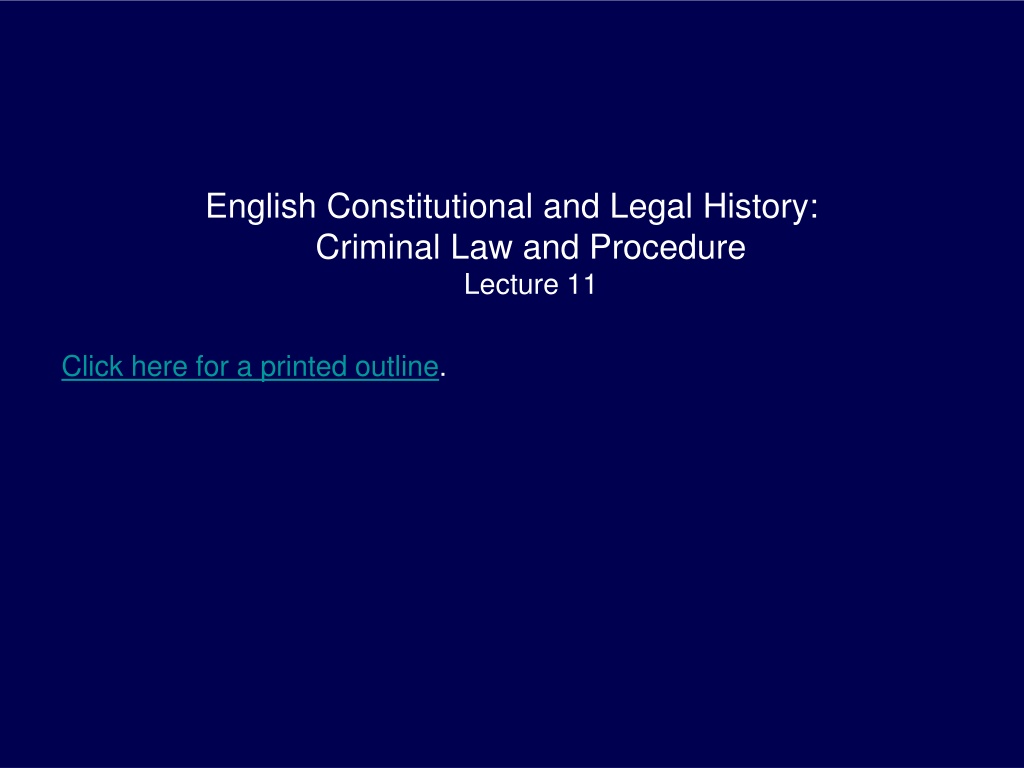







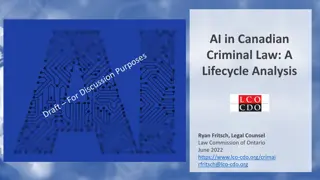
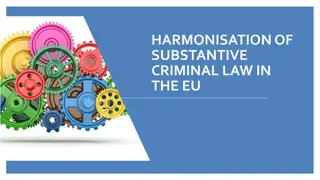
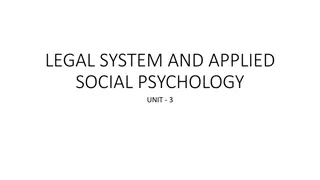
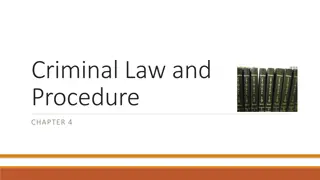

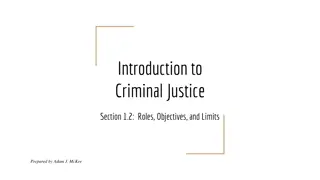
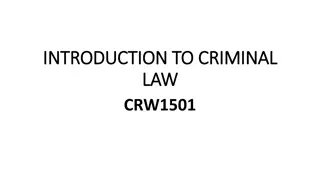
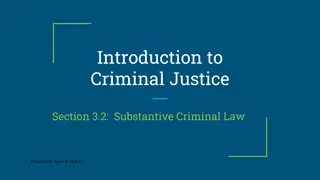
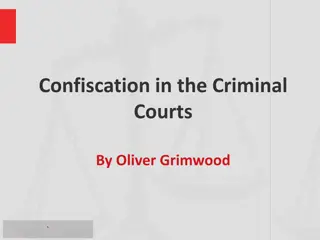
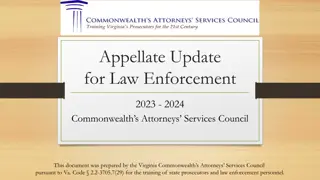

![Briefing on the Criminal Procedure Amendment Bill [B12-2021] to the Portfolio Committee on Justice and Correctional Services](/thumb/157093/briefing-on-the-criminal-procedure-amendment-bill-b12-2021-to-the-portfolio-committee-on-justice-and-correctional-services.jpg)
